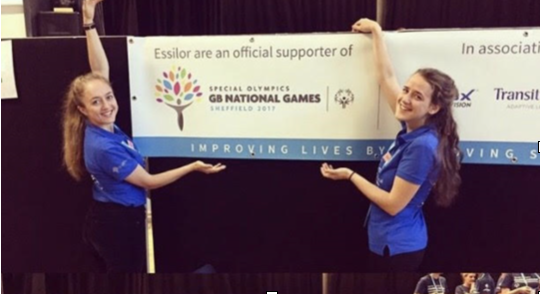Article – Why study Optometry at University Emma Cooney
Leave a Comment
My name is Emma and I am a newly qualified optometrist in a busy Specsavers practice in South Wales. I am really passionate about my job, I find Optometry stimulating and rewarding. Each patient offers a new challenge – one day is never the same as the next. An average day can vary from diagnosing serious eye conditions to fitting contact lenses.
Our sight is so important. Studies show that people are more afraid of losing their sight than they are of developing serious general health conditions, such as cancer or Alzheimer’s. Enabling a patient to make the most of their vision is hugely satisfying.
So what led me to pursue a career in optics?
I was always attracted to maths and science at school. I didn’t want to work in a laboratory – I wanted a hands on job, interacting with people and I wanted to make a difference. University application deadlines are daunting for any 17/18 year old. To explore my future career options, I enrolled on a work experience placement at my local Opticians. From my very first day I knew I had found the career for me. I was fascinated by the tests carried out by the optometrist and was amazed at what systemic conditions could be detected during a routine eye examination. Diseases such as diabetes and high blood pressure can manifest on the retina, whilst high cholesterol can be detected on the cornea. I was enthralled by how confidently the optometrist explained these findings to the patient and then referred the patient onto their GP or to the eye hospital.
On deciding to pursue a career in Optometry, the small matter of achieving the A Level grades remained. The A Level grades required for entry into UK University study for a BSc Optometry are high, usually AAB, and two of the A levels must be in science based subjects or maths.
My career to date
I started my career with the best three years of my life to date at the University of Manchester. Optometry is an intense and challenging degree programme but varied and interesting. The degree opened the door not only to the career I love, but to the best of friends.
Teaching is split between theory and practical sessions. During my first semester I dissected an eye and tested my first member of the public…albeit a paid volunteer patient! Testing a stranger’s eyes is a daunting experience initially. Thankfully, my patient had been volunteering with the university for over 30 years so was able to give me a few hints and tips. The university organised hospital placements within the NHS and private sectors. Cataract surgery is one of the most common surgeries in the UK. Watching the surgery for the first time is not for the faint-hearted but fascinating none the less. Cataract surgery is life-changing, being a part of the patient’s journey is a humbling experience. Universities aim to inspire a passion for research. During my second year, an opportunity arose for a research scholarship with an internationally renowned company. I was fortunate enough to be selected. I wrote an article about my findings and was later invited to present my work alongside leading experts at a global conference.
After graduating from a UK Optometry University students undertake a pre-registration year. During this year students are supervised in practice by an on-site optometrist. This year is a huge learning curve, all the theory and practical skills gained at university are put to the test. Translating text book to real life scenarios is a challenge but luckily my supervisor was with me every step of the way.
Other career opportunities
Optometry is constantly evolving and provides a myriad of opportunities. Optometrists can work in high street, independent and hospital practice. Alternatively pioneering research is currently being undertaken in universities all over the world. There is potential for a bionic eye which aims to restore some vision to blind patients, ground-breaking research is exploring routes to prevent the wide spread issue of myopia (short-sightedness) and scientists are exploring ways of measuring diabetic’s blood sugar levels with a contact lens.
There are more opportunities available in the voluntary sector. Charities, such as Vision Aid Overseas and Fight for Sight, organise voluntary excursions to developing countries. 1.2 billion people globally are unable to see purely because they require spectacles, the majority of these people live in developing countries. These charities aim to reduce this number by offering free sight tests and spectacles to the world’s most needy.
To date, my volunteering experience has been closer to home. I volunteered in a homeless shelter offering free sight tests and glasses to homeless people and I spent a week vision screening at the Special Needs Olympics. The Special Needs Olympics is a global event which takes place every four years. Meeting and examining the eyes of the athletes was an enjoyable and memorable experience – we even made it to the track to cheer on some of our patients!
Would I recommend a career in Optometry?
Without a shadow of a doubt! The science of Optometry is rapidly changing. It is such an exciting time to be a part of this field. The job has been revolutionised over the past 50 years and I am looking forward to being part of its future.